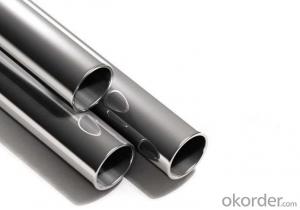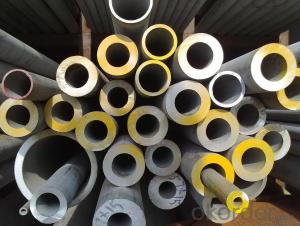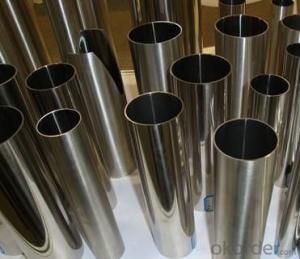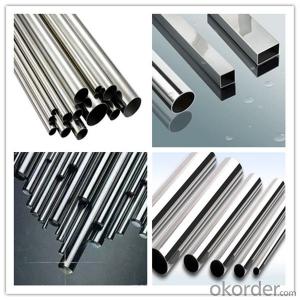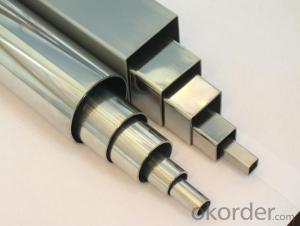304 Stainless Steel Pipe
- Loading Port:
- China main port
- Payment Terms:
- TT OR LC
- Min Order Qty:
- 5 m.t.
- Supply Capability:
- 100000 m.t./month
OKorder Service Pledge
OKorder Financial Service
You Might Also Like

304 stainless steel pipe price list
Our Advantages
You can get a competitive price with high quality.
We can provide sample for your evaluation.
We can provide Mill test certificate.
Your enquiry will get quickist and efficient response.
Introduction of grade 304
304 stainless steel material is a kind of common stainless steel materials, corrosion prevention is better than 200 series stainless steel materials. High resistance to high temperature is also better, it can reach to 1000-1200 degrees. 304 stainless steel has good corrosion,corrosion resistance and good resistance to intergranular corrosion. For oxidizing acid, obtained in the experiment, the concentration of 65% or less under the boiling temperature of nitric acid, 304 stainless steel has a strong corrosion resistance. To most organic and inorganic acid and alkali solution with good corrosion resistance ability.
Physical properties
Tensile strength σb (MPa): 520
Conditions yield strength 0.2 sigma (MPa) :205
Elongation δ5 (%) :40
Section shrinkage ψ (%): 60
Hardness: ≤187HB ≤90HRB≤200HV
Some details of our products
| Product: | 304 stainless steel pipe price list |
| Grade: | 304; sus304; 1.4301; |
| Standard: | ASTM,AISI,JIS,EN,DIN,GB |
| Surface treatment: | 8k, ba, hl |
| Thickness: | 0.4-30mm |
| Outer Diameter | 20-400mm |
| Productivity: | 900MT/Month |
| Products range | hot rolled stainless steel sheet, hot rolled stainless steel coil, hot rolled flat steel,cold rolled stainless steel sheet, cold rolled stainless steel coil, Industrial tube, decorative tube |
Trade terms
| Product | 304 stainless steel pipe price list |
| MOQ: | 5 Ton |
| Payment Term: | 1. 30%T/T in advance ,the balance against the B/L copy 2. 30%T/T in advance ,the balance against the L/C at sight 3. 100%L/C at sight |
| Price Term: | FOB/CFR/CIF |
| Delivery: | 1.10 days after receiving the deposit of T/T 2.10 days after receiving the L/C original |
| Packaging: | Standard Export Packing |


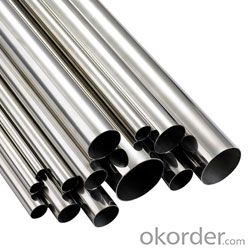
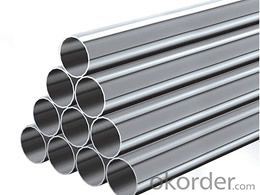
- Q:Can stainless steel pipes be used for steam systems?
- Stainless steel pipes are indeed suitable for steam systems due to their remarkable resistance to corrosion and high temperatures. This material is renowned for its ability to carry steam without deteriorating or corroding, thus ensuring the efficiency and safety of the steam system. Moreover, stainless steel pipes possess low thermal conductivity, which aids in reducing heat loss during the transportation of steam. Consequently, these pipes are highly favored in diverse industries for their durability, reliability, and long lifespan.
- Q:What is the difference between Schedule and Nominal Pipe Sizes for stainless steel pipes?
- The difference between Schedule and Nominal Pipe Sizes for stainless steel pipes lies in their respective measurements. Schedule refers to the wall thickness of the pipe, while Nominal Pipe Size (NPS) indicates the approximate inside diameter of the pipe. The Schedule system is based on a standard thickness range, denoted by a specific number, such as Schedule 40 or Schedule 80, which are commonly used in industrial applications. On the other hand, NPS provides a standardized label for pipes that corresponds to a specific inside diameter, regardless of the wall thickness. Therefore, while Schedule determines the strength and pressure rating of a stainless steel pipe, NPS primarily denotes its size for compatibility with fittings and other components.
- Q:What's the difference between stainless steel 302 and 304?
- [difference] 302 stainless steel and 304 stainless steel 304 stainless steel is one of the most widely used kind of chromium - nickel stainless steel, as a widely used steel, corrosion resistance, good heat resistance, low temperature strength and mechanical properties; punching, bending and other thermal processing, non hardening heat treatment (using temperature -196 to 800 DEG C). 302 stainless steel the carbon is relatively high (302 C = 0.15%; 304 C is less than or equal to 0.08%) and better strength. The other indicators are basically the same as those of 304.
- Q:Can stainless steel pipes be used for steam piping?
- Yes, stainless steel pipes can be used for steam piping. Stainless steel is highly resistant to corrosion and can withstand high temperatures, making it an excellent choice for steam applications where durability and longevity are important.
- Q:How do you prevent stress corrosion cracking in stainless steel pipes?
- One way to prevent stress corrosion cracking in stainless steel pipes is to ensure proper material selection. Using stainless steel grades that are resistant to stress corrosion cracking, such as duplex or super duplex stainless steel, can significantly reduce the risk. Additionally, maintaining a suitable environment by controlling temperature, pH levels, and exposure to corrosive substances can also help prevent stress corrosion cracking. Regular inspection and maintenance, including cleaning and passivation, can further enhance the integrity and durability of stainless steel pipes, minimizing the chances of stress corrosion cracking.
- Q:Are stainless steel pipes suitable for sewage treatment plants?
- Stainless steel pipes are indeed appropriate for sewage treatment plants. This is because stainless steel is an incredibly tough and corrosion-resistant material, which makes it well-suited for the harsh and corrosive conditions commonly found in sewage treatment plants. The material's superior resistance to corrosion prevents the pipes from deteriorating over time, ensuring a lengthier lifespan and reducing the necessity for frequent maintenance or replacements. Moreover, stainless steel pipes possess exceptional hygienic qualities, which are vital for sewage treatment plants to maintain proper sanitation. The smooth surface of these pipes prevents the accumulation of bacteria, biofilm, and other contaminants, making it easier to clean and sustain a high level of cleanliness. Additionally, stainless steel is environmentally friendly since it is entirely recyclable, thus contributing to sustainable practices in sewage treatment plants. In summary, stainless steel pipes are a dependable and suitable option for sewage treatment plants due to their durability, resistance to corrosion, hygienic properties, and eco-friendliness.
- Q:What is the difference between seamless and drawn-over-mandrel stainless steel pipes?
- Seamless stainless steel pipes and drawn-over-mandrel (DOM) stainless steel pipes are two different types of stainless steel pipes that vary in their manufacturing process and physical properties. Seamless stainless steel pipes are made by piercing a solid cylindrical billet of stainless steel and then extruding it to form a seamless tube. This process ensures a consistent and uniform thickness throughout the pipe, resulting in a smooth and seamless appearance. Seamless pipes are known for their high strength and pressure resistance, making them suitable for applications that require reliable and durable piping systems. On the other hand, drawn-over-mandrel stainless steel pipes are made by forming a hollow tube from a solid cylindrical billet through a series of drawing operations. The tube is then subjected to a mandrel inside to improve its shape and size accuracy. This process gives the pipe a uniform wall thickness and a smooth internal surface. DOM pipes are known for their excellent dimensional accuracy and tight tolerances, making them suitable for applications that require precise and consistent pipe dimensions. In terms of physical properties, seamless stainless steel pipes generally have higher tensile strength and yield strength compared to DOM pipes. This makes seamless pipes more suitable for high-pressure and high-stress applications, such as in the oil and gas industry. DOM pipes, on the other hand, offer better dimensional control and surface finish, making them ideal for applications that require precise fitting and smooth flow, such as in the automotive and hydraulic industries. In summary, the main difference between seamless and drawn-over-mandrel stainless steel pipes lies in their manufacturing process and physical properties. Seamless pipes are made by extruding a solid billet, resulting in a smooth and seamless appearance, while DOM pipes are made by drawing a hollow tube from a solid billet, resulting in excellent dimensional accuracy. The choice between the two types of pipes depends on the specific requirements of the application, such as pressure resistance, dimensional accuracy, and surface finish.
- Q:Are stainless steel pipes suitable for vacuum systems?
- Yes, stainless steel pipes are suitable for vacuum systems. Stainless steel has excellent corrosion resistance and high strength, making it ideal for handling the low pressure and potential moisture present in vacuum systems. Additionally, stainless steel pipes have high thermal conductivity, which aids in maintaining the desired vacuum level.
- Q:What is the difference between 304F and 316F stainless steel pipes?
- The main difference between 304F and 316F stainless steel pipes lies in their composition and characteristics. 304F stainless steel is an austenitic stainless steel, which means it contains high levels of chromium and nickel. It is known for its excellent corrosion resistance, weldability, and formability. This makes it a popular choice for various applications, including pipes used in industries such as food processing, chemical processing, and construction. However, 304F stainless steel is not as resistant to chloride corrosion as 316F stainless steel. On the other hand, 316F stainless steel is also an austenitic stainless steel, but it contains higher levels of chromium, nickel, and molybdenum compared to 304F stainless steel. The addition of molybdenum provides enhanced corrosion resistance, particularly against chlorides and other aggressive chemicals. This makes 316F stainless steel pipes suitable for more demanding applications, such as marine environments, where exposure to saltwater and corrosive chemicals is common. In summary, the main difference between 304F and 316F stainless steel pipes is their corrosion resistance. While both are austenitic stainless steels, 316F stainless steel offers superior resistance to chloride corrosion, making it a better choice for applications where corrosion resistance is critical.
- Q:What is the difference between seamless and extruded stainless steel pipes?
- The main difference between seamless and extruded stainless steel pipes lies in their manufacturing process. Seamless stainless steel pipes are produced by piercing a solid billet of stainless steel and then rolling it to the desired shape and size without any seams. On the other hand, extruded stainless steel pipes are created by forcing the molten stainless steel through a die to form the desired shape. This process results in a seamless pipe with consistent thickness throughout. In summary, seamless pipes are made by rolling a solid billet while extruded pipes are formed by forcing molten stainless steel through a die.
1. Manufacturer Overview |
|
|---|---|
| Location | |
| Year Established | |
| Annual Output Value | |
| Main Markets | |
| Company Certifications | |
2. Manufacturer Certificates |
|
|---|---|
| a) Certification Name | |
| Range | |
| Reference | |
| Validity Period | |
3. Manufacturer Capability |
|
|---|---|
| a)Trade Capacity | |
| Nearest Port | |
| Export Percentage | |
| No.of Employees in Trade Department | |
| Language Spoken: | |
| b)Factory Information | |
| Factory Size: | |
| No. of Production Lines | |
| Contract Manufacturing | |
| Product Price Range | |
Send your message to us
304 Stainless Steel Pipe
- Loading Port:
- China main port
- Payment Terms:
- TT OR LC
- Min Order Qty:
- 5 m.t.
- Supply Capability:
- 100000 m.t./month
OKorder Service Pledge
OKorder Financial Service
Similar products
New products
Hot products
Hot Searches
Related keywords


